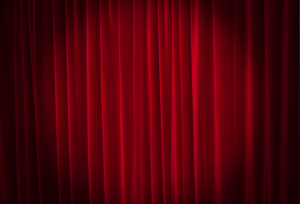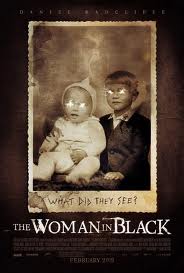Review
>
THE WOMAN IN BLACK: Watch It At Home – Fun, But Creaky As Its Doors
THE WOMAN IN BLACK is so aggressively old-fashioned it sometimes feels like the horror movie version of The Artist. A haunted house story in the grand style, it may be in color and wide-screen, but its heart is with the black-and-white thrillers of an earlier age, and at a time when the genre seems interested in little more than shock-therapy soundtracks and extreme gore, its restraint can be charming.
Jane Goldman’s script (she’s co-written most of Matthew Vaughn’s movies, including Stardust, Kick-Ass and X-Men: First Class), based on Susan Hill’s novel, is set early in the 20th century, in a remote English village where the lady of the local great house has died. London solicitor Arthur Kipps (Daniel Radcliffe, in his first significant post-Harry Potter role) is sent down to go through the dead woman’s papers and set her estate in order. Arthur is himself something of a wreck–his wife died in childbirth, and his grief threatens to estrange him from his young son.
His troubles, of course, have only started. Just about everyone in town makes it clear they don’t want him there, he begins to learn about the dreadful secrets of the house’s inhabitants, and when he insists on entering the old place to do his job, it turns out to be very much on the creepy side. You name it: locked doors that unexpectedly open, rocking chairs that rock intensely without anyone being seated, a very insistently loud crow, jnexplicable faces at the windows, and wouldn’t you know it, a mysterious Woman In Black who appears in the family cemetery and then everywhere else. Meanwhile, something terrible is starting to happen to the children in town.
 Director James Watkins embraces every creak, thump and roar of the old house, sometimes to a fault. If you’ve ever seen a horror movie before, the long-silence-then-boo! moments become all too obvious and predictable when they’re repeated a dozen times. And although it’s a time-honored cliche to have the protagonist wander alone through the thickly silent darkness of the haunted abode, that trope is also used here to the point of self-parody. The movie could have used some modicum of a sense of humor, and a few more people on hand besides Radcliffe and Ciaran Hinds and Janet McTeer as a couple with very different views about the supernatural.
Director James Watkins embraces every creak, thump and roar of the old house, sometimes to a fault. If you’ve ever seen a horror movie before, the long-silence-then-boo! moments become all too obvious and predictable when they’re repeated a dozen times. And although it’s a time-honored cliche to have the protagonist wander alone through the thickly silent darkness of the haunted abode, that trope is also used here to the point of self-parody. The movie could have used some modicum of a sense of humor, and a few more people on hand besides Radcliffe and Ciaran Hinds and Janet McTeer as a couple with very different views about the supernatural.Nevertheless, for the most part the movie works in its retro way. Radcliffe proves he can hold the camera without spectacles, wand or forehead scar, and he’s convincing as a young father. The production design of the house and town (by Kaye Quinn) and the superbly atmospheric photography (by Tim Maurice-Jones) are marvelously dank, although Marco Beltrami’s score is disappointingly obvious. And the script has a few surprises in the late going, even if the final one is more fantasy than horror.
The Woman In Black is one of the first new pictures made by the revivified Hammer studio, a new version of the company that produced many of the Christopher Lee and Peter Cushing British horror classics of the 1950s-60s. Like it’s forebears, it’s a a solidly fun piece of unpretentious entertainment.



